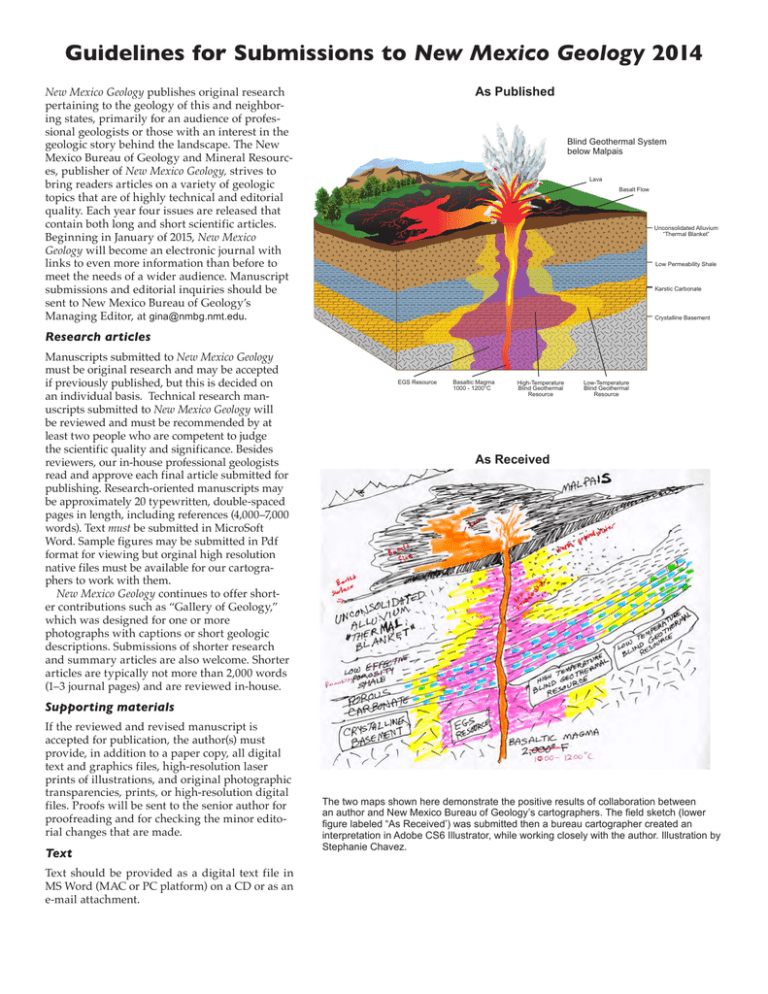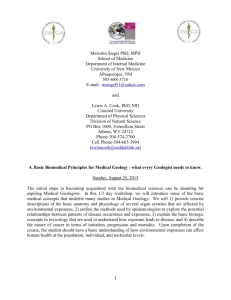New Mexico Geology As Published
advertisement

Guidelines for Submissions to New Mexico Geology 2014 New Mexico Geology publishes original research pertaining to the geology of this and neighboring states, primarily for an audience of professional geologists or those with an interest in the geologic story behind the landscape. The New Mexico Bureau of Geology and Mineral Resources, publisher of New Mexico Geology, strives to bring readers articles on a variety of geologic topics that are of highly technical and editorial quality. Each year four issues are released that contain both long and short scientific articles. Beginning in January of 2015, New Mexico Geology will become an electronic journal with links to even more information than before to meet the needs of a wider audience. Manuscript submissions and editorial inquiries should be sent to New Mexico Bureau of Geology’s Managing Editor, at gina@nmbg.nmt.edu. As Published Blind Geothermal System below Malpais Lava Basalt Flow Unconsolidated Alluvium “Thermal Blanket” Low Permeability Shale Karstic Carbonate Crystalline Basement Research articles Manuscripts submitted to New Mexico Geology must be original research and may be accepted if previously published, but this is decided on an individual basis. Technical research manuscripts submitted to New Mexico Geology will be reviewed and must be recommended by at least two people who are competent to judge the scientific quality and significance. Besides reviewers, our in-house professional geologists read and approve each final article submitted for publishing. Research-oriented manuscripts may be approximately 20 typewritten, double-spaced pages in length, including references (4,000–7,000 words). Text must be submitted in MicroSoft Word. Sample figures may be submitted in Pdf format for viewing but orginal high resolution native files must be available for our cartographers to work with them. New Mexico Geology continues to offer shorter contributions such as “Gallery of Geology,” which was designed for one or more photographs with captions or short geologic descriptions. Submissions of shorter research and summary articles are also welcome. Shorter articles are typically not more than 2,000 words (1–3 journal pages) and are reviewed in-house. EGS Resource Basaltic Magma 1000 - 1200°C High-Temperature Blind Geothermal Resource Low-Temperature Blind Geothermal Resource As Received Supporting materials If the reviewed and revised manuscript is accepted for publication, the author(s) must provide, in addition to a paper copy, all digital text and graphics files, high-resolution laser prints of illustrations, and original photographic transparencies, prints, or high-resolution digital files. Proofs will be sent to the senior author for proofreading and for checking the minor editorial changes that are made. Text Text should be provided as a digital text file in MS Word (MAC or PC platform) on a CD or as an e-mail attachment. The two maps shown here demonstrate the positive results of collaboration between an author and New Mexico Bureau of Geology’s cartographers. The field sketch (lower figure labeled “As Received’) was submitted then a bureau cartographer created an interpretation in Adobe CS6 Illustrator, while working closely with the author. Illustration by Stephanie Chavez. Illustrations Illustrations provided in electronic format (MAC or PC) should be in Adobe Illustrator editable files. Generic editable eps or Pdf files might be acceptable. All versions of Powerpoint, Canvas, and Corel Draw should be avoided and may not be accepted. For Arc export instructions, contact the cartography department. Graphics should be constructed in CMYK; any blacks need to be 100% black. Graphics files should not be embedded in the manuscript text file. All digital graphics files should be accompanied by a 300 dpi laser print. Photographs Photographs should be submitted as high resolution, 300 dpi or higher, color or black and white digital .tif, JPEG, or RAW formats. Low-resolution 72 dpi files, JPEG, or otherwise are NOT acceptable. PLEASE...do not write directly on photographic prints. Overlays should be illustrated on a photocopy. We will prepare final digital overlays. Tables Tables provided in electronic format (MAC or PC) should be tab delimited MS Word files or Excel spreadsheets. Inquiries about text or table file formats should be sent to the Managing Editor. Copyright Publications of the New Mexico Bureau of Geology and Mineral Resources, printed and electronic, are protected by the copyright laws of the United States and are not in the public domain. Copyright is held by the state of New Mexico through the bureau and New Mexico Tech. Authors and photographers who contribute works to bureau publications but who are neither federal nor New Mexico state employees retain copyright on the content of their individual works. The bureau requests only non-exclusive use rights from non-bureau authors allowing us to print and reprint the work and to distribute the work in print and in electronic/ digital format. No material from our website or printed and electronic publications may be reprinted or redistributed by others without the bureau’s permission. Contact the Managing Editor for permissions. Why do we want editable files? Our readers benefit from writing and illustrations that are clear, concise, and of geoinfo.nmt.edu/publications/periodicals/ nmg/ for examples of reference style and for maps, charts, and photographic applications. As Published 35.260° As Received uniform style. To this end we offer cartographic support as needed by individual authors. Sometimes we receive graphics in software other than Adobe Illustrator (.ai), or we receive .ai, .eps, or Pdf files that were exported to Adobe Illustrator from a different graphics program. The export function, although usually reliable, can alter fonts, symbols, line weights, and other characteristics of the original illustration. Some graphics programs were not designed for print publications. For these reasons we ask authors to send “editable” .ai, .eps, or Pdf files. Editable files also allow our cartographers to make specific content changes requested by the author and editor, and to make changes for conformity with bureau style. Techniques in the preparation and reproduction of illustrations change, and authors are encouraged to seek the advice of bureau cartographers Leo Gabaldon, leog@nmbg.nmt. edu, 575/835-5529 or Stephanie Chavez, schavez @nmbg.nmt.edu, 575/835-6961. Prospective authors are directed to view New Mexico Geology at http://www. 35.258° T1 T2 T3 35.256° L? Radio Towers 4 5 3 4 5 3 C La Mosca Lookout 35.250° 35.252° 35.254° EL 107.600° 107.598° 107.596° 107.594° 107.592° 107.590° 0 200 m contour interval 20 feet The two maps shown here demonstrate the positive results of collaboration between an author and NMG’s editors and cartographers. The map below was submitted (from a PowerPoint pesentation) and a bureau cartographer redrafted it in Adobe Illustrator from a scan of the original paper map. Cartography by Leo Gabaldon.




